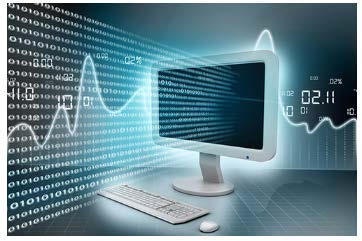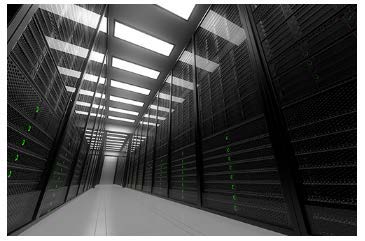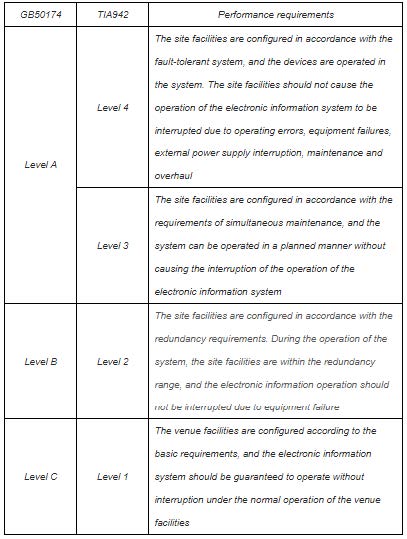Ⅰ.What is data center?
Data center usually refers to the centralized processing, storage, transmission, exchange, and management of data and information in a physical space. It generally contains key equipment such as computer equipment, server equipment, network equipment, communication equipment, and storage equipment. The infrastructure of the data center refers to the basic project designed and configured to ensure the safe, stable and reliable operation of the key equipment and devices of the data center, also called the computer room. The construction of the data center computer room engineering is not only for the operation and management of the system equipment of the data center To provide a guarantee environment for data and information security, but also to create a working environment for health matters.
A data center can be composed of a group of buildings, buildings, or several floors or parts of a building. Under normal circumstances, it consists of a computer room and support space, and is a center for storage, processing and circulation of electronic information. The core data processing equipment placed in the data center is the information center of government agencies, enterprises and institutions. The establishment of the data center is to comprehensively, centrally, proactively and effectively manage and optimize the IT infrastructure, to achieve a high level of manageability, availability, reliability and scalability of the information system, to ensure the smooth operation of the business and the timely service provide.
There are multiple types of data centers to meet specific business requirements. The two most commontypes are corporate/enterprise data centers and hosting/Internet data centers. Enterprise data centers are owned and operated by companies and institutions with independent legal personality or by government agencies. These data centers provide their own institutions, units, and personnel with data processing and Web-oriented services that support intranet and Internet. Operation and maintenance are carried out by the internal IT department. The hosting/Internet data center is owned and operated by telecommunications business operators, Internet service providers and commercial telecommunications business operators. They provide outsourced information technology (IT) services that are accessed via an Internet connection. They provide Internet access, Web or application hosting, colocation and controlled server and storage networks. Regardless of how the data center system is implemented, there are some basic principles or concerns for the data center, which should be given enough attention when planning the infrastructure of each data center.

1.Manageability
Building a high-performance network for users is not blindly complicated and expensive. Management is the most basic element. Without management, the basic wiring network can only meet the needs of the data center in the short term. If it is necessary to enhance the control and management of the basicnetwork of the data center, then a structured wiring system must be built to avoid the existence of A disorderly managed environment composed of a large number of hard-to-recognize jumpers.
2.Flexibility and scalability
The flexibility and scalability of the basic wiring allows for quick and easy implementation without serious impact on the daily operation of the data center, which is to reduce the risk of changes in the basic wiring caused by the use of new application technologies in the future. The scalability of the data center is very important for the system's future high-bandwidth upgrade and performance expansion without interruption. Therefore, we must pay attention to the various system components used to realize the network topology can effectively improve the network efficiency, save time and cost.
3.Network efficiency
Due to the growth of the number and scale of data centers, and the continuous evolution of the network and the development of 100G Ethernet, the future should continue to grow on high bandwidth. Due to the predictable growth of data centers, the basic wiring network requires a simple and effective wiring system to maximize the use of space and effectively reduce installation time and costs. For a well-planned basic wiring system, one should consider applications that can support 15 to 20 years and several generations of network system equipment and data rate growth.

Ⅱ. Data center system composition
The data center can be divided into a computer room and other support spaces in terms of function: the computer room is mainly used for the installation, operation and maintenance of electronic information processing, storage, exchange and transmission equipment, including the server room, network room, storage room, etc. The functional areas are installed with server equipment (also host or minicomputer), storage area network (SAN) and network attached storage (NAS) equipment, tape backup systems, network switches, and cabinets/racks, cables, and configuration Cable equipment and cable channels, etc.

The support space is the space outside the computer room dedicated to the installation and work of facilities supporting the operation of the data center, including the incoming line room, telecommunications room, administrative area, auxiliary area and support area. For a complete data center, it not only contains various types of functional areas. Such as: host area, server area, storage area, network area and control room, operator room, test room, equipment room, telecommunications room, incoming line room, data room, spare parts room, office, meeting room, lounge, etc. . It also includes the integrated wiring system, which is an important part of the data center and supports the connection, intercommunication and operation of the entire functional area network. The integrated wiring system usually consists of twisted-pair cables, optical cables, connecting devices and various wiring equipment. And while meeting the bandwidth demand for a period of time in the future, it will give consideration to cost performance. Therefore, it is essential to ensure that the design of a data center cabling solution can meet the needs of higher transmission rates in the future.
Chart 1: Data center space separation

In Chart 1 above:
1)The office area in the area outside the computer room of the building can be connected with thetelecommunications room on the building floor and the building entry room by horizontal cables;
2)The telecommunications room on the building floor can be communicated with the building inlet roomthrough the backbone cable;
3)The administrative area, auxiliary area, support area and the support space of the support space ofthe computer room can be connected with the main cable through the main cable;
4)The main cable can be used to communicate between the room's support space and the building'sinlet room;
5)The computer room supports the communication between the space telecommunications room andthe building telecommunications room and the incoming line through the backbone cable;
6)The main cable can be used to communicate between the site in the computer room and thesupporting space telecommunications room and incoming line room.
Ⅲ.Data Center Type
1.Data centers are classified by function
There are four main types of data centers: computer room, telecommunications room, control room, shielded room, etc. These computer rooms have the commonality of electronic computer rooms, but also have their own characteristics. They cover different contents and functions.
1)Computer room
Important data processing equipment, storage equipment, network transmission equipment and computer room security equipment are placed in the computer room. The construction of the computer room should consider the normal operation of the above equipment to ensure the safety of information and data and the needs of the physical and mental health of the staff.
The large computer room is generally composed of an unmanned area computer rooms generally include small computer rooms, server rooms, storage rooms, network computer rooms, media storage rooms, air-conditioning equipment rooms, UPS equipment rooms, power distribution rooms, etc.; manned computer rooms generally include master control center computer rooms, R&D computer rooms, and testing rooms. Computer room, equipment test room, equipment maintenance storage room, buffer room, changing room, rest room, etc. Small and medium-sized computer rooms can combine small computer rooms, server rooms, and storage rooms into one host room.
2)Telecommunications closet
The telecommunications room is a valuable resource for each telecommunications operator. The rational, effective and full use of the telecommunications room is of great significance to the operation and maintenance of equipment, rapid handling of equipment failures, reducing costs, and improving the core competitiveness of enterprises. Telecommunications equipment rooms are generally divided and arranged according to different functions and professions, and are usually divided into equipment rooms, supporting equipment rooms and auxiliary equipment rooms.
The equipment room is a building space used to install a certain type of communication equipment to realize a certain communication function, and is convenient to complete the operation, maintenance and production in the corresponding professional. It is generally composed of a transmission room, a switch room, and a network room. The supporting computer room is a building space used to install equipment to ensure the normal, safe and stable operation of communication facilities. It generally consists of a billing center, a network management monitoring room, a power battery room, a power distribution room, and an oil engine room.
Auxiliary computer room is a room that guarantees production, office, and life needs in addition to the communication facility computer room. Generally, it consists of the operation and maintenance office, operation and maintenance duty room, data room, spare parts library, fire protection room, fresh air fan room, cylinder room and toilet, etc. composition. In general intelligent buildings, the communication room is often built together with the computer network room.
3)Control room
With the development of intelligent buildings, in order to realize the control of intelligent building equipment in buildings, it is necessary to set up a control room. Compared with the data room and the telecommunications room, the control room has a smaller area, simpler functions, and lower environmental requirements. But it is related to the safe operation of intelligent buildings and the normal use of equipment and facilities.
The control room includes building intelligent control room, security monitoring room, fire control room, satellite receiver room, video conference control room, etc. The common feature of these control rooms is that there are operators working in the computer rooms. While ensuring the operation of electronic equipment, they must also ensure the physical needs of the operators. According to the requirements of equipment and operation, these control rooms also have their corresponding characteristics.
①Building intelligent control room. Mainly used to place the mainframe and control equipment ofintelligent building control, real-time monitoring of the public lighting, air-conditioning system, elevator and mechanical and electrical equipment such as wind, water and electricity in the intelligent building to ensure the safe operation of the intelligent building.
②Security monitoring room. Built-in monitoring host and terminal display equipment, to the buildingentrances, garages, walkways, elevator cars, Carry out video surveillance, anti-theft alarm, etc.
③Fire control room. It is the control center of automatic fire alarm and linkage system, and it is also thefire fighting command and information center in case of fire. It has a very important position and function. The "Code for Fire Protection Design of High-Rise Civil Buildings" and "Code for Fire Protection Design of Buildings" clearly stipulate the setting range, location, and building fire resistance of the fire monitoring room, and put forward principled requirements for its main functions.
④Satellite receiver room. It is mainly used to place satellite receivers, modems, mixers, amplifiers,wired and optical cable access equipment, and various frequency band receiving displays. The satellite receiver room is generally located on the top floor of the building, which is conducive to the transmission of satellite TV signals.
⑤Video conference control room. Mainly used to place the main control unit (MCU) of the videoconference, audio mixer, sound reinforcement system, signal transmission equipment, console equipment, signal source cabinet, etc. However, due to the small area of the general video conference control room, the equipment should be arranged flexibly according to the specific situation of the room.
4)Shielded computer room
In order to effectively prevent the influence of electromagnetic noise and radiation on electronic equipment and measuring instruments, and to prevent the leakage of electronic signals from threatening the security of confidential information, state agencies, military, public security, banks, railways and other units need to establish shielded computer rooms. The data room with confidentiality requirements should be shielded room to ensure that the signal does not leak during data processing, so as to meet the requirements for data confidentiality. Some environments with high requirements for electromagnetic resistance, such as communication equipment test laboratories and other places, need to build shielded equipment rooms to prevent external electromagnetic signals. The computer room with strong electromagnetic equipment should carry out corresponding electromagnetic shielding treatment to avoid the normal operation of the equipment near the computer room.
2.Data centers are classified by level
According to the Chinese standard GB50174 "Code for Design of Electronic Information System Computer Room", the data center can be based on the location of the computer room, building structure, computer room environment, safety management and the nature of the computer room, as well as the interruption of the electronic information system operation due to the failure of the site equipment in the economy and society. The degree of loss or impact caused is divided into three levels: A, B and C.
Class A is fault-tolerant. During the period when the system needs to operate, the site equipment should not cause the operation of the electronic information system to be interrupted due to operating errors, equipment failure, external power supply interruption, maintenance and overhaul.
Level B is a redundant type. During the period when the system needs to operate, the site equipment is within the scope of the redundancy capability, and the operation of the electronic information system should not be interrupted due to equipment failure.
Class C is the basic type. Under the normal operation of the site equipment, the operation of the electronic information system should be guaranteed uninterrupted
Foreign TIA942 divides data centers into 4 levels according to the normal operation time supported by data centers. Different levels require different facilities in the data center. The higher the level, the stricter the requirements.
T1 Data Center: Basic type. This type of data center uses a single route without redundant design.
T2 data center: component redundancy, or use a single path to increase component redundancy.
T3 data center: online maintenance, with multiple paths, single-channel equipment, T3 computer room should be easily upgraded to T4 computer room.
T4 Data Center: A fault-tolerant system with multiple active paths to enhance fault tolerance.
In the four different levels of definitions, different requirements for building structure, electrical, grounding, fire protection and telecommunication infrastructure safety are included. Table 2 shows the availability index of the TIA942 standard data center level.
Chart 2: Available indicators of different levels of data centers in the TIA942 standard

By comparing the availability and redundancy of data centers, we have established a reference relationship between data centers of different levels described in domestic and foreign standards. See Table 3 below.
Chart 3: Correspondence between domestic and foreign data center levels

categories
recent posts
scan to wechat:everexceed
